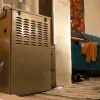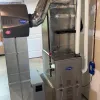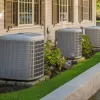Many homeowners love to spray foam insulation, and it’s easy to understand why. Compared to traditional insulation, whether fiberglass or cellulose, spray foam has the potential to provide better performance via its air-sealing properties, high R-values per inch of thickness, and, in the case of closed-cell spray foam, the ability to repel moisture.
Oh, and when you put it in your attic, spray foam insulates the attic itself. You increase the amount of usable space inside your home!
We are neither pro-spray foam nor anti-spray foam.
At PV Heating, Cooling & Plumbing, we recognize that spray foam is an insulation choice that some people make for their homes. As for whether you should use spray foam, we are a neutral party. Many homeowners love spray foam for the reasons stated. Others aren’t so keen on it. Regardless, spray foam is in many homes and is likely here to stay.
Of course, it’s always better to consider these things before you opt for spray foam, but it’s common for people to apply spray foam before thinking about these issues. Let’s explore the five primary ways spray foam impacts HVAC performance.
1. Your HVAC system might suddenly be too large for your home.
For heating and air conditioning systems, size is a big deal. Well-insulated homes with minimal air leakage often require smaller HVAC systems than poorly insulated, leaky homes, even when those homes are otherwise identical.
When a system is too small, it won’t heat or cool a home adequately. However, what’s just as bad – and it’s a much more common problem! – is an HVAC system that’s too large. During the summer, an oversized air conditioner might satisfy your thermostat setting without issue. But it won’t run long enough to remove much humidity from your indoor air, leaving you sweaty and uncomfortable.
What does all of this have to do with spray foam insulation? Quite a lot!
Spray foam insulation does double duty when it comes to energy efficiency. It insulates (duh!) and seals air gaps between your home and the outdoors. In most respects, that’s a good thing. However, your existing HVAC system, which was perfectly suited to a leaky, marginally insulated home, may now be too large for your well-sealed, properly insulated home.

Have you ever heard the expression, “No good deed goes unpunished?” that’s what’s going on here.
To remove a sufficient amount of humidity in summer, you may need to set your thermostat to a lower temperature than would otherwise feel comfortable. Sure, you could replace your HVAC system with a properly sized (presumably smaller) one, but your existing system might not be old enough to justify replacement. There’s also this option:
2. You might need a whole-house dehumidifier.
A lot of people opt for a whole-house dehumidifier after spray foaming their attic. To better manage the higher humidity resulting from shorter AC run cycles, the whole-house dehumidifier removes moisture from the home until it satisfies a humidistat setting, typically something between 45% and 55% relative humidity (RH).
A whole-house dehumidifier is less expensive than a new air conditioner. It also solves your humidity problem without forcing you to set your thermostat to an uncomfortably low temperature.
3. Spray foam insulation may prevent your home from getting enough ventilation.
Spray foam provides an air seal. Generally speaking, that’s a good thing. A well-sealed home does a better job of keeping conditioned air inside.
However, all homes need some ventilation. Otherwise, contaminants can accumulate and linger in your indoor air. VOCs, allergens, outdoor pollutants… you want to bring fresh air in so that you can flush those things out. In some cases, spray foam insulation can prevent your home from getting enough fresh air.
How do you know what’s happening? Only a blower door test will reveal whether your home is properly ventilated. Even though your air may not have been particularly “fresh” in the past (unless you were using a mechanical ventilation system, it was just outdoor air leaking in), you still benefited somewhat from the exchange of indoor and outdoor air.
In our climate zone, there are two controlled options for bringing fresh air into your airtight home:
- Ventilating dehumidifier: This is the same whole-house dehumidifier mentioned before, only it comes with an additional duct/mechanical damper add-on that’s connected to the dehumidifier return. The damper opens according to a pre-set schedule matched to the home’s fresh air needs, providing properly filtered, positive-pressure ventilation.
- Energy recovery ventilator (ERV): An ERV provides balanced air exchange between a home and the outdoors. Whenever it brings in filtered outdoor air, it expels an equal amount of your home’s indoor air. It also transfers some moisture from the incoming air to the outgoing air, so the air you bring in isn’t necessarily as humid as the air outside.
If a blower door test reveals that your spray foam insulation reduced ventilation beyond an acceptable level, you may need to install one of these units in your home.
4. High attic humidity often results from spray foam insulation.
Sometimes, humidity levels spike in an attic after a spray foam job. To see whether this is happening in your attic, it’s a good idea to monitor RH using a humidistat with a remote sensor. Check the RH levels in your attic over a few weeks to see if the air is holding a lot of moisture.
If you have high humidity in your spray foamed attic, there are a variety of things that might be causing the problem. It could be because the spray foam contractor didn’t seal off all the air leaks. Gable vents and soffits are the big offenders here, but there may be other areas of leakage.
Duct leakage is another potential issue. If you’ve got a lot of return leakage, your attic might be under negative pressure. Much of the make-up air will then enter your attic from the outdoors, which increases the RH inside the attic. Similarly, a powerful kitchen fan might create a negative pressure environment in your home, pulling lots of outdoor air into the attic.
The solution? Seal all attic air leaks and leaks in your air return. If your kitchen fan is causing the problem, get a smaller one or provide a pathway for make-up air.
If all else fails, you can install a dehumidifier in the attic or run some air conditioning ducts up there. The dehumidifier is preferred since your air conditioner will only dehumidify the attic while the system is running. Adding AC to the attic will also put the space under positive pressure, possibly forcing attic air into your living space.
5. Got an 80% furnace in your attic? With spray foam, it might not get enough combustion air.
If you’re reading this article in the winter and you’re running an atmospherically vented furnace in a spray-foamed attic, drop what you’re doing right now and buy a low-level carbon monoxide detector. You could have a dangerous problem on your hands.
Spray-foamed attics aren’t intended to have any ventilation. That’s fine for energy efficiency, but it’s really bad for a furnace that’s designed to live in a ventilated environment. Furnaces that use the surrounding air for combustion need ventilation. If there’s not enough ventilation for combustion air, the furnace could backdraft carbon monoxide (CO) into your home.
If you’ve got an 80% furnace, you really shouldn’t get spray foam insulation unless one of the following is true:
- The spray foam contractor installs a combustion damper to provide combustion air, a so-so solution that can jeopardize the integrity of your spray foam project (since it’s an air leak in the spray foam)
- The spray foam contractor installs louvered grilles between your attic and your living space; these allow the furnace to use air from your home for the combustion process. Note that this isn’t a good idea if you have a very airtight, high-performance home or if your home simply isn’t large enough to provide the air needed for combustion.
- You’re going to get a sealed combustion furnace around the same time you pursue the spray foam job. Sealed combustion furnaces suck combustion air through a dedicated pipe. They don’t need to be in a ventilated environment
Getting a sealed combustion furnace is far and away the best option here. Dampers and louvered grilles may work, but they’ve got to be installed properly. Installing the right kind of furnace in the first place is more of a sure thing.
Do you already have spray foam in your attic? Have your contractor perform a depressurization test to determine whether the attic qualifies as a “confined space.” The test results will let you know whether the furnace is getting enough combustion air. When it isn’t, you need to take action.
Address these issues before putting spray foam insulation in your attic.
If you’ve already got spray foam and you’re experiencing any of the problems we’ve described here, know that there are solutions. Humidity and ventilation management are, in fact, manageable. So are issues related to furnaces and combustion safety.
Spray foam insulation can be a solid choice for many homeowners. Just be aware of the potential consequences so you can mitigate them beforehand.






